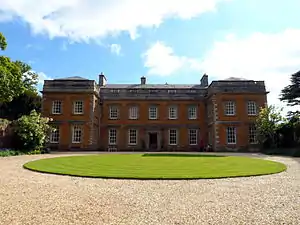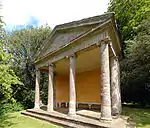Farnborough Hall
Farnborough Hall is a country house in Warwickshire, England near to the town of Banbury, (grid reference SP4349). The property has been owned by the National Trust since 1960 when the Holbech family endowed it to them, and is still run for the National Trust by Geoffrey Holbech's daughter Caroline Beddall. It is a Grade I[1] listed building.

The Holbech family acquired the Farnborough estate in 1684 and the honey-coloured (Hornton) stone house was built soon after. The family first moved into the house in 1692, and apart from in both World War 1 and World War 2 when the house was used as an auxiliary hospital, the family have lived in the main house and it remains the seat of the Holbech family.
William Holbech bought the estate in 1684 and built the house but the major changes to the property occurred between 1745 and 1750 when the entrance front was remodelled and the rococo plasterwork was added to the interior. This work was carried out by William Holbech (son of William Holbech who bought the estate) who wanted a suitable setting for the sculpture and art he had brought back from his Grand Tour around Italy, particularly Venice. His close friend was the painter Canaletto who was commissioned to produce four artworks (in two orders) to hang in the main Dining Room. Three paintings by Pannini were also commissioned by William Holbech. The originals of the Canaletto and Pannini paintings were sold in the 1920s after the First War but copies still hang today in their place today. He used designs by his close friend Sanderson Miller for the landscape, an architect, who lived a few miles away. Sanderson Miller's good friend was a little known man at the time but who went on to design most of the great landscapes that still exist today, his name was Capability Brown. Long Palladian facades with sash windows, pedimented doorways and a balustraded roofline were also added to the earlier classical west front.
Unlike many of its contemporaries, Farnborough Hall and its landscaped gardens have experienced little alteration in the last 200 years and they remain largely as William Holbech left them. The house has been described by historians as a "small but exquisite" country house with the original Roman busts and plasterwork being exemplary, but with the main attraction to visitors being the Sanderson Miller landscape and gardens, including the Rose Garden and Orangery (since demolished) that was designed by Henry Hakewill in the early 19th century as part of extensive remodelling of the gardens at the time.
The entrance opens straight into the Italianate hall. The walls are adorned with busts of Roman emperors set into oval niches and the panelled ceiling is stuccoed with rococo motifs. The dining room on the south front was especially designed to display works by Canaletto and Giovanni Paolo Panini. The original works are long gone, being replaced by copies. The drawing room has panels of elaborate stuccowork featuring scrolls, shells, fruit and flowers; these serve as a framework for more Italian works of art. A stucco garland of fruit and flowers encircles the skylight above the staircase hall.
Gardens
In the mid 18th century the gardens were significantly enhanced by architect Sanderson Miller to dramatic effect. The land at the front of the Hall slopes downward to give a view of lake below. To the left of the house a grassy Terrace Walk is flanked by trees and excellent views of the Warwickshire plain can be had from here. The terrace leads past an Ionic temple and an oval pavilion, which has two storeys and elaborate plasterwork, to an obelisk at the end of the walk. The 80 feet (24 m) high obelisk was completed in 1751 (rebuilt in 1828 after it collapsed in 1823) and contains the name of Italian prisoners of war that were inscribed on the base during World War Two.[2]
 West side
West side West side
West side South side
South side
Terrace Walk
 Ionic Temple
Ionic Temple Oval Pavilion
Oval Pavilion
 Obelisk
Obelisk
Rose Garden
 Rose Garden
Rose Garden Rose Garden
Rose Garden
References
- British Listed Buildings
- Nicholson, Jean et al: The Obelisks of Warwickshire, page 19. Brewin Books, 2013
External links
![]() Media related to Farnborough Hall, Warwickshire at Wikimedia Commons
Media related to Farnborough Hall, Warwickshire at Wikimedia Commons